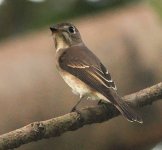Bryon Wright
Well-known member
Flycatcher
Gandytron,
good choice, the underside of the beaks in the photos are broad but not virtually triangular as in most Brown. The numerous browns in your local patch, can some have side markings like DSF?
Gandytron,
good choice, the underside of the beaks in the photos are broad but not virtually triangular as in most Brown. The numerous browns in your local patch, can some have side markings like DSF?





